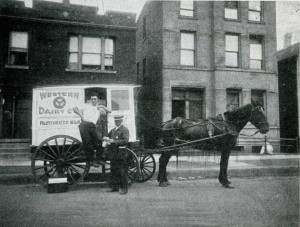Horses were the animal most closely integrated with urban America during the nineteenth century. Many twenty-first century Chicagoans picture horses as something people rode around on until automobiles became available. This is not true. Horses drew wagons which served as trucks, taxis, buses, etc. City folk walked or took street cars (often pulled by horses), rode steam trains, boats etc.
Statistics tell the story. The 1908 City Clerk’s Annual Report shows that Chicago had three horse-drawn or motor vehicles per 100 persons. By 2000, there were 42 motor vehicles per 100 persons.
Among large animals horses have the most complex relationship with humans. A personal aside will illustrate this. My grandfather returned from his stint in France with the Marines in 1920. He bought a car and set out as a traveling salesman. During the winter he parked the car in a barn and used a horse and sleigh. My grandmother, of course, was the farmer’s daughter.
During the next forty years he was in the business of delivering milk. He alternated between horses and trucks. Horses were superior in the milk business. Not only were horses more energy efficient, but they actively helped. He would hop out of the wagon with a heavy crate of milk bottles. The horse would amble along to the next customer and stop. My grandfather would run with the empties, grab a full crate and repeat the process. The horse pictured was just as helpful.




Add a comment to: Working Horses: Technology That Changed Chicago